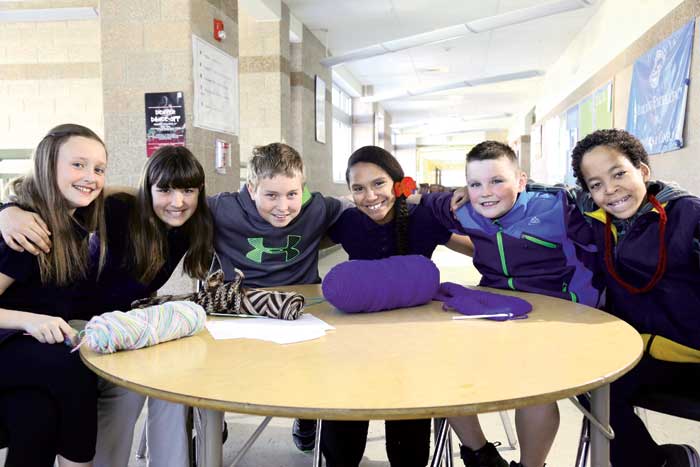Meet The Kids: Oddball, endearing and quirky answers to life’s questions

Bill Roberts fifth graders left to right: Ellie Gould, Lindsey Trussell, Trevor Delong, Jameelah Vigil, Bracken Welles and Alexzander Austin.
Sometimes the most intriguing insight lies in unexpected places.
Enter Ms. Barbara Cramer’s fifth-grade class at William Roberts Elementary. Like bugs to a light, curious 11-year-olds gather around and talk while simultaneously crocheting, some with such well-trained fingers they do it without looking.
The class is knitting and crocheting scarves for the homeless. The class just completed a unit studying homelessness in the United States, which according to the Homelessness Research Institute, makes up 20 per every 10,000 people. Throughout the unit, many students’ views on the problem have changed.
Six students—Ellie Gould, Lindsey Trussell, Trevor Delong, Jameelah Vigil, Bracken Welles and Alexzander Austin—share their thoughts.
“At the beginning I thought it was their fault they are homeless,” Bracken Welles says. The group of students all agree they initially thought homeless people are dirty, crazy, irresponsible and addicted to drugs or alcohol.
Soon they discovered not all homelessness looks the same. Many people try to hide their homelessness, making it a quiet crisis. “Now I know that you can see somebody, and they might be homeless, and you wouldn’t even know it,” Jameelah Vigil says.
While they say some people make bad choices that make them homeless, it’s also not always a person’s fault. Alexzander Austin says small problems in someone’s life can grow into big problems, even homelessness. Unfair evictions, job loss, illness, language barriers or financial struggle can lead to homelessness, the group says. “The number one issue of homelessness is housing prices, and how it’s too expensive,” Ellie Gould says.

Ms. Barbara Cramer’s fifth grade class crochets and knits scarves for the homeless as part of their study on homelessness in the U.S.
The group understands homelessness as a daily struggle for survival. Austin says, “I would be scared and worried if I were homeless. I would think nobody cared about me.”
The group imagines a day in the life of a homeless person, bouncing ideas off one another. What would be the best lake or river to shower in? Would a hospital help you? How could you pay for the bill? After reading about poor conditions in shelters, Austin says, “What I think is the shelters care about you, but they want you to leave.”
So whose job is it to help homeless people?
“It’s the government’s,” Austin says instantly.
“It’s both the government’s and the person’s,” Bracken says. “They have to try to get themselves out, but they need someone else to help them.”
Trevor Delong says the homeless usually can’t get a decent job so they need extra financial support.
Is the government doing a good job helping the homeless? Lindsey Trussell quickly shakes her head. The group says the U.S. is the 35th richest nation but second in child poverty. Trussell quotes Ghandi: “The measure of a civilization is how it treats its weakest members.” She says the U.S. doesn’t measure well, overlooking the homeless problem.
“It’s like there’s a crack on the door, and the government is just putting a Band-Aid on it,” Bracken says. “It’s not going to fix it permanently.”
“It’s responding to it, not solving it,” Trussell adds. Heads nod, and “yes” echoes all around. The group agrees the government can fix the problem at its source by focusing on preventing people from becoming homeless, like adding affordable housing.
Donating items is the best way to help the homeless at a local level, according to the fifth-graders. “But you shouldn’t assume what homeless people need because you shouldn’t judge,” Vigil notes. Giving money to people on the street is risky, they say, although Austin admits he “sneak does it” sometimes. Gould says, “My mom pays a lot of tax money to shelters so I don’t do that.”
Along with the scarves, the class donated pencils, puzzles, games, cards and coloring books in gift baskets to the Colorado Coalition for the Homeless. They enjoyed the unit and are happy to understand what homeless people go through. Ms. Cramer says they continue to crochet.
Each month Front Porch writer Madeline Schroeder visits one neighborhood elementary or middle school and chats with a group of students, rotating schools and talking to different age groups. Last month’s conversation was with Isabella Bird students about friendship. Principals or teachers interested in being a part of “Meet The Kids” can email Madeline at madeline@box2438.temp.domains.


Perhaps the key to eventually overcoming our homeless population’s situation will come from this (fifth grade’s) generation’s research and understandings. Kudos to these kids for doing what they can, and in their way!!